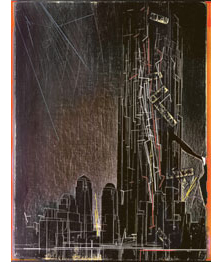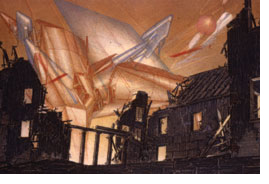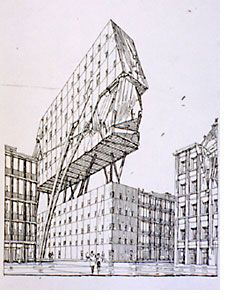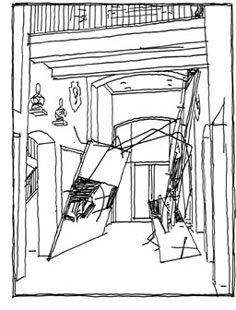The
Reality of Experimental Architecture:
An Interview
with
Lebbeus Woods
By Lorrie Flom
 In
July 2004, the Heinz Architectural Center will open
a surprising new exhibition/ installation called Lebbeus
Woods: Experimental Architecture. Woods is a
graduate of the Purdue University School of Engineering
and
the University of Illinois School of Architecture.
Since 1976, he has concentrated on theory and experimental
projects. He has exhibited, lectured on, and published
his projects worldwide, and written numerous articles
about architectural practice and theory. He is the
co-founder and scientific director of the Research
Institute for Experimental Architecture and has been
a visiting professor at several schools, including
The Bartlett in London and Harvard and Columbia Universities.
Currently he is professor of architecture at The
Cooper Union in New York City. In
July 2004, the Heinz Architectural Center will open
a surprising new exhibition/ installation called Lebbeus
Woods: Experimental Architecture. Woods is a
graduate of the Purdue University School of Engineering
and
the University of Illinois School of Architecture.
Since 1976, he has concentrated on theory and experimental
projects. He has exhibited, lectured on, and published
his projects worldwide, and written numerous articles
about architectural practice and theory. He is the
co-founder and scientific director of the Research
Institute for Experimental Architecture and has been
a visiting professor at several schools, including
The Bartlett in London and Harvard and Columbia Universities.
Currently he is professor of architecture at The
Cooper Union in New York City.
Wherever Woods exhibits his
drawings, models, and engulfing architectural installations,
his work generates both
discussion and controversy. To help set the stage
for this fascinating exhibition, which is being organized
by Tracy Myers, curator of the Heinz Architectural
Center at Carnegie Museum of Art, CARNEGIE magazine
interviewed the architect.
CM: Most people think
of architecture as thoughtful design resulting in
buildings. How do you define
architecture?
LW: I think architecture is about ideas in the
first place. You don’t get to design until you have
an idea. That idea has to be somewhat comprehensive.
There’s always a client asking for a building.
If you’re an architect, you’ll design the
building. But if you’re a dutiful architect,
you first have to question why the building is required.
The architect has to take responsibility to participate
in the rationale of the building and not just to design.
The architect can either say we don’t need this
building and walk away, or maybe we need a different
kind of building. That’s why I don’t have
a lot of clients. [Chuckle.] Architecture requires
the critical questioning of many things—it’s
not just a thoughtful carrying out of a client’s
wishes.
CM: What do you hope the general public will get out
of this exhibition?
LW: I hope they enjoy it and that it
stimulates them to think about their experience of
space and design.
This exhibition, more than most architectural exhibitions,
is designed as a spatial exhibition. The design is
an architectural experience—it’s not just
looking at artifacts. Also, I hope they are able to
understand the point of view that architecture has
an experimental dimension. Changing society requires
us to do things differently, and we can only find out
by experimenting. Happily, architects can do this with
drawings and models.
They don’t have to build 200 million dollar buildings
that are disasters to test an idea. We can try ideas
out on a different scale and medium.
 CM: Before you went fully into experimental architecture,
you were working for a traditional architectural firm
and designing buildings that were built. You just said
that when things are changing dramatically, architects
have to view things differently. Did some dramatic
event change your way of thinking, or did this evolve
for you? CM: Before you went fully into experimental architecture,
you were working for a traditional architectural firm
and designing buildings that were built. You just said
that when things are changing dramatically, architects
have to view things differently. Did some dramatic
event change your way of thinking, or did this evolve
for you?
LW: I was in my 20s in the 1960s. I
wasn’t a
politically oriented person. I was married and had
two children. I worked for a big corporate firm on
the east coast. The ‘60s were a time of questioning
and instigating change. One of the things that happened
was that the idea of “normal” as it related
to modern architecture—square buildings and curtain
walls and so-called “functional planning”—began
to be challenged by people like Robert Venturi and
Denise Scott Brown. It was a time during which the
best architects were beginning to look at architecture
differently than they had for the last 30 to 40 years.
Then there was the whole social revolution of the ‘60s,
which had to do with equal rights, making a better
society. I wasn’t political; I wasn’t marching;
I wasn’t demonstrating; I didn’t have long
hair. But intellectually, I realized that architecture
had to be more than just a kind of service provided
to people who wanted to build standard things.
In the ‘70s
I began to make my own moves in that direction. I was
looking for an architecture that embodied
spontaneity, unpredictability. It doesn’t have
to be radical like people marching in the streets.
So-called “normal life” was no longer normal,
and I was trying to determine, “How do you give
it its space? How do you give it its architecture?”
CM: Some of your works, such as the Havana and Sarajevo
projects, seem to be political statements. Do you view
your work as a way to express your politics?
LW: My work is
political, but it is not party politics, not ideology.
I view politics as the kind of machinery
by which we change our lives. In that sense, these
projects make a political statement. Both Havana and
Sarajevo have political histories beyond my ability
to analyze, but I felt obligated to respond as an architect.
 In
Sarajevo and Havana, the whole fabric of society
was changing. These may be extreme cases, but they
also present a chance to see ourselves. We’re
now facing the same problems they were facing. The
siege of Sarajevo, the destruction of the city in the
early ‘90s, was a kind of prelude to what happened
in New York to the World Trade Center towers. It’s
similar in the sense that terrorists were attacking
civil life...attacking a way of life. By looking at
extreme cases such as these, we have a chance to understand
our own situations better. At the edge, we can see
the forces of change where the normal has broken down.
When normal reaches its limits, we have to, as architects,
think differently about what buildings do. In
Sarajevo and Havana, the whole fabric of society
was changing. These may be extreme cases, but they
also present a chance to see ourselves. We’re
now facing the same problems they were facing. The
siege of Sarajevo, the destruction of the city in the
early ‘90s, was a kind of prelude to what happened
in New York to the World Trade Center towers. It’s
similar in the sense that terrorists were attacking
civil life...attacking a way of life. By looking at
extreme cases such as these, we have a chance to understand
our own situations better. At the edge, we can see
the forces of change where the normal has broken down.
When normal reaches its limits, we have to, as architects,
think differently about what buildings do.
CM: Do you believe any of your works will ever be
built?
LW: I believe they’re built as soon as I draw
them. It’s a form of constructing the idea. If
there is no idea in the drawing, there is no idea in
the constructed project. That’s the expression
of the idea. Architects make drawings that other people
build. I make the drawings. If someone wants to build
from those, that’s up to them. I feel I’m
making architecture. I believe the building comes into
being as soon as it’s drawn. Obviously, every
architect would like to see most of their designs built,
including me.
CM: Your work is driven by real world situations,
yet to most viewers, the results are far from reality.
How can visitors close that gap?
LW: I want to
provoke questions. I’ve never felt
that I provide a definitive, conclusive answer to anything.
But there are some very important questions, neglected
usually in the architectural discourse, and they have
to do with the volatility of contemporary life. And,
buildings of stone, steel, glass, and concrete don’t
answer those questions.
 Maybe it’s temporary
architecture. A lot of my work is about questioning
the stability and permanence
of architecture, and, in turn, the stability of society.
In a sense, life is a kind of dance. Life is a kind
of performance. We have to loosen up and be freer
and more adaptive. Maybe it’s temporary
architecture. A lot of my work is about questioning
the stability and permanence
of architecture, and, in turn, the stability of society.
In a sense, life is a kind of dance. Life is a kind
of performance. We have to loosen up and be freer
and more adaptive.
I’m trying to bring people
in rather than saying, “Here
is another product offered by another architect.” I’m
trying to say, “Here is a set of conditions…what
do you think?” The gap is important. If there’s
not a gap, there’s nothing left. The gap is
what you’re supposed to think about. Over the
years I’ve had many exhibitions of my work,
and there are people who are willing to go along
with it. If
something grabs them, it’s because there’s
something in the work that is authentic. It comes
from a struggle with ideas.
CM: Is there a way for viewers to appreciate
what you do without fully understanding your philosophy?
LW: A range
of reactions is expected and good. There will be
people who will shake their heads and say, “Architecture
should be functional. This isn’t functional.” They
may hate it.
In any creative medium, there has to be
substance for the work to hold up. For example, a
piece of music
is not an answer. It’s a stimulus. It leads
you to thinking and feeling a certain way, which
you wouldn’t
have done without that particular experience.
If
you go to a concert, and there’s something
genuine in the music it will grab you. You can
listen to Schubert’s Ave Maria and it’s
a beautiful, lyrical melody. It may be the type
of music you are
most familiar with. Or, you could listen to Pierre
Boulez and other electronic music and wonder whether
it’s truly music. But if you really listen
to it, to the structure of the music and the playfulness
and the interplay of all the parts, that requires
a
higher degree of perceptiveness than a more familiar
piece. The work has to hold up. There has to be
something there that is immediately present.
People
who come to this exhibition are going to
see the tremendous effort that was made to bring
them
in. They will experience visual and spatial energy.
They’ll
see things they haven’t seen before. They’ll
be engaged. And then they can draw their own conclusions.
No one will go away thinking, “That was a
dull exhibition.” They won’t forget
it. It will stay with them, and that’s
the goal.
_________________________________________________________________
Generous support for this exhibition has been provided
by the Ann and William Boyd, Jr. Fund for Architecture
and Elise Jaffe and Jeffrey Brown. Special support
for the exhibition catalogue, Lebbeus Woods: Experimental
Architecture, has been provided by the Graham Foundation
for Advanced Studies in the Fine Arts, Chicago.
The programs of the Heinz Architectural Center are
made possible by the generosity of the Drue Heinz Trust.
General support for museum programs is provided by
the Pennsylvania Council on the Arts and The Heinz
Endowments.
Back to Contents |